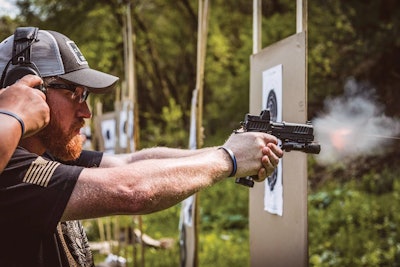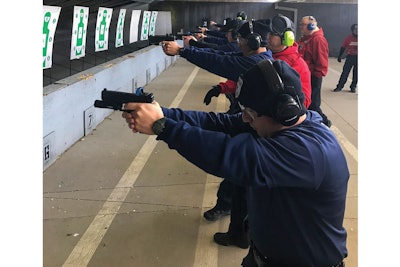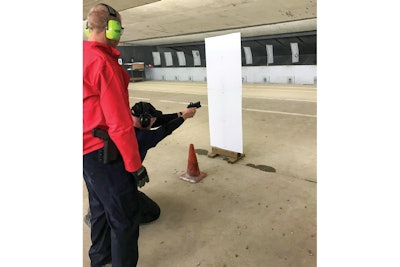 Police trainer Jim Dexter of the Lisle (IL) Police Department demonstrates the proper technique for shooting a pistol outfitted with red dot optics.Photo: Tactically Sound
Police trainer Jim Dexter of the Lisle (IL) Police Department demonstrates the proper technique for shooting a pistol outfitted with red dot optics.Photo: Tactically Sound
More and more law enforcement agencies are now allowing their officers to train with red dot sights on their duty handguns and to use these optics on their duty weapons. Some agencies are even issuing the handgun optics. And at least one—the Houston Police Department—has made red dot optics mandatory on the duty pistols of recruits.
Three years ago, a red dot sight (RDS) on a duty pistol would have been unusual. Now, some experts believe these optics may soon be standard equipment on police pistols. (Note: All references to RDS in the rest of this article will refer to handgun sights.)
Sgt. Bill Campbell of the Gilbert (AZ) Police Department and an NRA expert on handgun optics says RDS on duty weapons is following the same trend that weapon lights on duty pistols did a few years ago. He explains that three things—pistol accessory rails, rugged lights, and light-accommodating duty holsters—had to evolve for weapon lights to catch on in police work and the same had to happen for RDS. "What we were waiting for with red dots was more rugged sights, duty pistols designed to use the sights, and duty holsters designed specifically for pistols fitted with the sights," Campbell says.
Single Focal Plane
To understand why some firearms trainers are advocates of fitting officers' duty pistols with RDS, it's important to understand the difference between sighting with iron sights, which requires the eyes to perform a number of complex operations, and sighting with a reflex sight such as a red dot, which requires one.
Police trainer Jim Dexter, who serves with the Lisle (IL) Police Department, says the single focal plane sighting system of the RDS keeps officers focused on the threat during a shooting and that can make a big difference in performance. "When officers use red dots on pistols their reaction time and their ability to remain focused increase exponentially from traditional iron sights," he says.
Faster target acquisition is one of the best known advantages of using RDS instead of traditional sights. It's much easier to put a dot on a target and focus on that target while shooting than it is to align front sight and rear sight on a target.
Campbell says the targeting process used with an RDS works better with human physiology and psychology than traditional pistol sights. "We have a natural tendency during a fight or flight type of circumstance to keep our eyes focused on whatever it is that is endangering us," he explains. "It's very difficult for us to take our eyes off of that and put them on the sights of our pistol, which are these little metal objects held at arm's length from us."
In addition to rapid target acquisition, law enforcement trainers have discovered that students make faster follow-up shots when using pistols with RDS. "It allows faster split times because we don't have to go through that whole process of looking through both of those sights multiple times between shots. As soon as the red dot reappears on the target, we can begin prep and start pressing the trigger again," says Campbell.
Training Aid
Every expert contacted for this article wanted to dispel officers of the notion that adding a red dot sight to a pistol will magically make them better shooters. "There are seven principles of marksmanship and the red dot only simplifies two of them, which is sight alignment and sight picture," says Campbell. "All the other principles of marksmanship still have to be employed. So if you have a shooter who is all over the place because of really bad trigger control, the red dot is not going to help that person because it has nothing to do with managing his trigger control."
What a red dot can do is help both students and trainers see why the shots are "all over the place." Dexter says, "You can see what the dot is doing in relation to the target and your hits." He also recommends that officers use their red dots as dry-fire training tools. "I actually shoot an iron sighted gun better now than I ever did before, and I truly think that is the direct result of the work that I put in with a red dot in dry fire. My grip is better and my trigger control is better because I can see my mistakes. An RDS is such a great feedback device."
New Recruits
With more and more agencies allowing their veteran officers to take in-service training and carry red dots on their duty pistols, it was just a matter of time before red dots became a recruit training tool.
The Houston Police Department will soon be graduating its first class of recruits to train with red dot sights. Until the agency says otherwise, these new officers will carry Glock 17 MOS (Modular Optic System) pistols fitted with Trijicon RMR Type 2 LED Adjustable red dot sights.
 The Houston Police Department training staff developed its red dot program over several years of experimenting with the concepts and working with experienced red dot optic instructors.Photo: Houston (TX) Police Department
The Houston Police Department training staff developed its red dot program over several years of experimenting with the concepts and working with experienced red dot optic instructors.Photo: Houston (TX) Police Department
Houston PD Training Division Commander Kristine Anthony-Miller says the recruit red dot training program was developed by the firearms training staff with full approval from the brass. "We have had full support for this program from the executive staff and Chief (Art) Acevedo," she says.
The training staff developed the red dot program over several years of experimenting with the concepts and working with experienced red dot optic instructors. They also spent a lot of time experimenting with and torturing equipment. "We beat the living crud out of these red dots before deciding they were suitable for the cadets," Sandoval says.
The Houston PD red dot training program focuses on teaching officers to shoot using the dot first. That is a departure from the "iron sights first" approach favored by some duty pistol RDS programs. "When you teach dot your teaching target focus. And if you try to teach sights first, you're teaching front sight focus. Trying to go back the other way and teach target focus after teaching front sight focus actually makes it more difficult," Sandoval says.
The Houston program does teach iron sights, using the suppressor-height sights on the cadets' Glocks, but it teaches that the sights are a secondary system. "In our program, shooting with backup iron sights is a failure drill," Sandoval says. "We spend time on it but not the days and days that we used to before."
Some shooting instructors would disagree with the Houston PD's approach to cadet firearms training with RDS. But the results are hard to argue with.
Sandoval says the diagnostic abilities of the dot have made a huge difference in student performance. "You can see the dot move before you are about to shoot, so you see yourself tighten up or anticipate and flinch. It helps us get the ideas of grip and trigger control across quicker than we can with just iron sights. These cadets were at day three with the dot where they would have been at day six with sights and their groupings have been awesome," he says.
Veteran Officers
The Houston PD's focus on cadets for its RDS program is an intelligent approach, according to firearms instructors at other agencies who primarily work with veteran officers for in-service training. Veteran officers have to learn how to present their duty pistols toward the target so they can pick up the red dot first and not the sights and that requires them to rethink shooting.
Dexter teaches a transitional course for veteran officers through his company Tactically Sound (www.tacticallysound.org) and at his agency. He says it takes work to teach experienced shooters the new aiming method. "We're trying to counter 10 to 15 years of myelination (what is often called "muscle memory") about shooting," he says.
Campbell says it's a challenge teaching an officer who has been shooting with iron sights for years to shoot with a red dot. He uses himself as an example: "I've been a cop for 30 years and, when I had to transition to red dots, it took me a long time to stop looking at the front of the gun. I had to make myself focus on the target. It takes time. For me it took training and training and training before it became second nature."
 Law enforcement trainers have discovered that students make faster follow-up shots when using pistols with red dot sights.Photo: Houston (TX) Police Department
Law enforcement trainers have discovered that students make faster follow-up shots when using pistols with red dot sights.Photo: Houston (TX) Police Department
Even though learning red dots is tougher for senior officers, Campbell says the optics can offer them greater benefits than those experienced by new shooters. "For older officers who are starting to need reading glasses, it can be really difficult to see the front sight on their duty pistol unless they extend it way out. The red dot eliminates that problem. If they can see the target and a blob of red in the optic, then they can hit the target," he says.
Cost and Effort
There are many benefits to law enforcement agencies training their officers to use RDS on their duty pistols. There are also some concerns about implementing such a program.
One very important concern is that officers who carry red dots have to be willing to make sure they are in working order before heading out on patrol. "The officer has got to make a commitment to do the daily checklist to make sure that this thing is working correctly. That means the glass is clean, the battery is working, and the red dot is where it needs to be," says Campbell.
But the major disadvantage to red dots is the cost. The RDS is another piece of equipment that the officer or agency must purchase. "A good optic that is rugged enough for police work costs as much as the gun itself," says Campbell. Then there is the gun. Few officers are already carrying optics-ready pistols, so they have a choice of buying a new gun or having the slide and sights modified on their current duty weapon so that it can accommodate the optic.
Commander Anthony-Miller says that cost was a major concern for her Houston PD training unit when they were developing the cadet RDS program, especially since the cadets pay for their own equipment. The decision to move forward with the training came down to weighing the return on investment vs. the cost. "It pays for itself in the confidence and in the knowledge, skills, and ability that the cadets gain in this program," she says.
David Griffith is Editor of POLICE/PoliceMag.com.
















